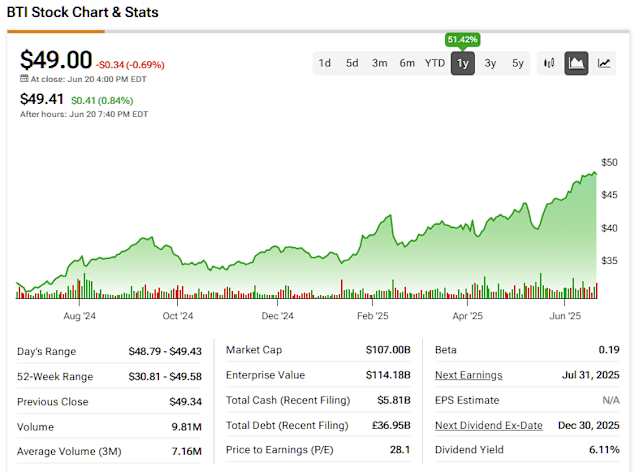British American Tobacco (BTI): A High-Yield Stock with Strong Growth Potential and Resilient Business Model Despite Recent Rally
British American Tobacco (BTI) has gained 51% over the past year, driven in part by investor demand for reliable dividend income amid growing expectations of lower interest rates. As a high-quality dividend payer with 29 consecutive years of dividend increases, BTI has performed well in such environments.
Combustibles Represent Steady Cash Cow for BTI
British American Tobacco's core combustible business, which includes brands like Camel and Lucky Strike, remains a powerhouse. In the latest trading update, management reported a return to growth in the U.S., a critical market, driven by stronger delivery in combustibles. Organic sales for combustibles nudged up 0.1% at constant rates, with a 5.3% price/mix improvement offsetting a 5.2% volume decline. This resilience is a remarkable achievement for a "struggling" tobacco major, as combustibles still account for over 80% of revenue.
Despite global smoking rates dropping at a rate of mid-single digits annually, BTI's ability to raise prices and maintain margins showcases its pricing power. Additionally, CEO Tadeu Marroco highlighted cost savings of £402 million in 2024, which will help counter inflationary pressures, such as higher leaf prices, making the strong sales seem all the more impressive. Overall, with the U.S. market showing signs of stabilization, combustibles continue to fund BTI's transformation while delivering steady cash flows for dividends and buybacks.

Smokeless Growth Accelerates to BTI's Advantage
BTI's pivot to "new categories," including vaping, heated tobacco, and oral nicotine products, is also gaining traction. The latest trading update highlighted an 8.9% organic revenue jump in these segments, with Velo Plus nicotine pouches leading the charge in the U.S. Management noted strong customer retention for Velo, which is closing the gap with Philip Morris's Zyn. Meanwhile, Glo Hilo, an upgraded heated tobacco device, is expanding into new markets, boosting competitiveness.
Though new categories contribute less than 15% of revenue compared to Philip Morris's (PM) 40%, BTI's innovation is paying off in my view. In fact, the company raised its 2025 revenue growth guidance to 1%-2% from 1%, citing better-than-expected first-half performance in modern oral products. The CEO's confidence in achieving 3-5% revenue growth by 2026 suggests that BTI's smokeless portfolio is no longer a side hustle or a bet but a meaningful growth driver.
BTI Remains a Bargain Despite Its Recent Rally
After a 57% rally, one might expect British American Tobacco (BTI) to look expensive—but it still trades at a forward P/E just under 11 while the sector median hovers at ~16, an attractive valuation even for a so-called "sin" stock. On a trailing twelve-month basis, BTI's P/E ratio is currently 28, while the sector average is 22, indicating that although the market may view BTI as slightly overvalued today, the next twelve months appear promising.
Moreover, the company continues to generate strong cash flow and has raised its dividend for 29 consecutive years. While the yield has declined from around 10% to 6.6%, this is a result of share price appreciation, not a dividend cut. In fact, if interest rates decline as expected, BTI's dependable yield could draw even more investor interest, potentially driving the stock higher.
The company's $1 billion share buyback last year, while modest relative to its $108 billion market cap, enhances the total shareholder return. Factoring in the buyback, the blended yield rises to about 7.5%, offering even more appeal. Altogether, BTI's low valuation
Despite the recent market rally, British American Tobacco (BTI) continues to stand as a high-yielding stock with impressive growth potential and an unparalleled resilience in its business model; making it one of this investment era's steady bet on sustainable returns.
BTI, the British American Tobacco stock listed as a prime candidate for high dividend yields and enduring business resilience during recent market fluctuations due to its strong growth potential even amidst economic uncertainties.
Despite the recent market upturn, British American Tobacco (BTI) continues to be a compelling high-yield stock with evident growth potential and an unwaveringly resilient business model.
Despite the recent market rally, British American Tobacco (BTI) remains a high-yield share with impressive growth potential and an inherently resilient business model due to its diversification across geographic markets.
British American Tobacco (BTI) stands as a high-yield share with notable growth prospects and an impressively resilient business model amidst market uncertainties, reinforcing its position among investors seeking stable dividends alongside potential for capital appreciation.
Despite the recent rally, British American Tobacco (BTI) remains a high-yield stock with proven resilience in its business model and strong growth potential that should attract conservative yet adventurous investors seeking consistent returns amidst market volatility.
British American Tobacco (BTI), despite a recent rally in the market, remains an attractively high-yielding stock with ample growth prospects and notable resilience evidenced through its robust business model.
British American Tobacco (BTI), with its robust high-yield dividend stock and resilient business model even after recent market rally phases, presents a captivating investment opportunity for investors seeking reliable growth potential amidst uncertainties.
While the recent market rally has pushed British American Tobacco (BTI) shares higher, their strong growth potential amid an increasingly resilient business model makes them a promising investment option with high-yield characteristics that continue to attract investors' attention.
British American Tobacco (BTI) offers an appealing high-yield investment opportunity with its resilient business model and strong growth potential, despite the recent market rally.
BTI, a high-yield stock with phenomenal growth potential and an unwaveringly resilient business model in the face of recent market fluctuations; it's safe to say that investing today could potentially yield highly rewarding returns tomorrow.














